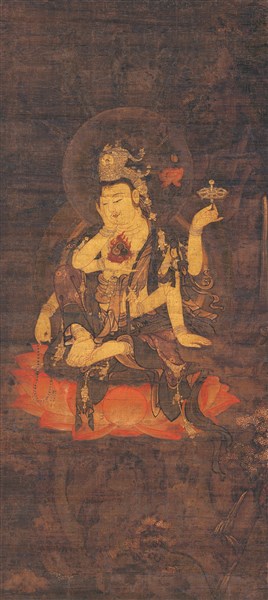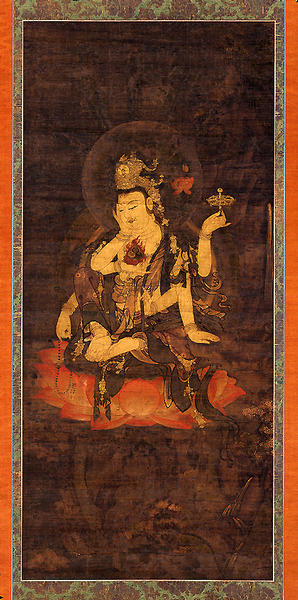如意輪観音像
- 鎌倉時代
- 13-14c
- 絹本著色
- H-80.7 W-36.4
- 所蔵
- 湯浅家旧蔵
如意輪観音は六観音の一つに数えられ、衆生に富を与える如意宝珠と苦しみから救う法輪を持つ菩薩とされる。考え深い表情に、金泥塗りの肉身を持ち、背景には滝を擁する山岳が描かれて、観音の浄土とされる補陀落山を表している。左第一手を置く光明山は、銀泥の岩が背後の山塊からせり出しており、より自然な形で表そうとする意識がうかがえる。
図録解説
鎌倉時代 13-14世紀
絹本著色
縦:80.7cm 横:36.4cm
如意輪観音は六観音の一つに数えられ,衆生に富を与える如意宝珠の徳と,衆生を苦難から救う法輪の徳を兼ね備えた菩薩とされる。二臂,四臂,六臂,十臂,十二臂像などがあるが,一般的なのは金剛智訳『観自在如意輪菩薩瑜伽法要』などに説かれる六臂像である。経典によるとその像容は,金色身で冠に化仏を戴き,右第一手は頬にあて,第二手は如意宝珠,第三手は念珠を持ち,左第一手は伸ばして光明山をやすんじ,第二手は蓮華,第三手は輪宝を持つとされる。本作品もこれに基づくものであるが,背景には滝を擁する山岳が描写されている。これは『華厳経』その他に説かれるように,観音の浄土とされる補陀落山を表したもので,平安後期からの画像にはこの種の図様が多い。
観音の肉身は金泥塗りとし,朱線で描き起こされる。着衣文様は截金を用いず,彩色と金泥のみからなる。条帛は丹地に金泥の雲気文,裳は暗赤色地に彩色団花文と白の雷文繋ぎ文を施している。また,裳の衣文線には墨線の上に朱線を重ねている。
左第一手の光明山は,平安仏画では台座の上にのる金色の小岩塊として表されるのが普通だが,本作品では,背後の山塊からせり出す格好に表されている。これは,鎌倉時代の如意輪画像の特色で,より自然な形式で表現しようとする意識がうかがえる。本作品の場合は,この箇所に銀泥を塗り,山塊から聖別している。左第三手の輪宝を斜め向きにとらえているのも,同じ意識の現れであろう。
背景の花樹には知恩院の早来迎と通じる感覚があり,像容や文様表現とも併せて,鎌倉時代後半の制作と思われる。なお,箱蓋畳紙には旧蔵者を示す「湯浅家蔵」の墨印がある。(泉)
Catalogue Entry
Kamakura period, 13th to 14th centuries
Hanging scroll, color on silk
Height, 80.7cm; width, 36.4cm
Nyoirin Kannon is one of the Six Kannon manifestations and is the Bosatsu (Bodhisattva) who embodies the merit of the nyoi jewel which gives wealth to the masses and that of the horin, wheel of the law, which saves the masses from calamity. This deity appears in 2-armed, 4-armed, 6-armed, 10-armed, and 12-armed forms, but the most common depiction is the 6-armed form as described in Kongochi's (Vajrabodhi) transcription of the Kanjizai Nyoirin Bosatsu Yuga Hoyo. According to the sutras, this deity has an entirely gold body, kebutsu figures appear in the deity's crown, the first right hand touches the cheek, the second right hand holds the nyoi jewel, the third right hand holds a rosary. The first left hand is extended and rests on the Mt. Potalaka the second left hand holds a lotus flower, and the third left hand holds the sacred wheel. While the present work is based on this iconography, an additional motif of a dragon twining around a mountain peak is shown in the background. As explained in the Kegon Sutra and other texts, this mountain is an image of Mt. Potalaka, the site of Kannon's paradise, and there are many examples of this kind of iconography in paintings beginning in the late Heian period.
Kannon's body is painted in gold paint, and the details are picked out in cinnabar red lines. There is no cut gold leaf use in the drapery motifs, only polychrome and gold paint motifs are used. The johaku has a tan red ground with gold paint cloud and mist motifs, and the mo is painted in a dark red ground with polychrome grouped floral motifs and white linked thunder motifs. Further, the drapery lines in the mo have cinnabar red lines layered on top of the black ink lines.
Normally, the Mt. Potalaka form seen at the first left hand of the figure is shown in Heian period painting as a small gold-colored boulder placed on top of the figure's pedestal, but this element is shown in the present work as a protrusion from the mountain behind the figure. This is one of the characteristics of Nyoirin iconography from the Kamakura period and reveals the desire to depict a more realistic form of the image. Here gold paint is used in this protruding area, and thus this section of the rock is sanctified, separate from the background mountain. The sacred wheel seen in the third left hand is shown from above and at an angle, and this depictive method is also indicative of the artist's realistic intentions.
The flowering tree in the background shares some of the sensibilities found in the Chion'in "Fast Raigo" image, and the combination of the overall appearance and the depiction of the motifs indicates that the work can be considered to have been created in the latter half of the Kamakura period. A black ink seal reading "Yuasakezo" impressed on the folded paper on the lid of the box for the painting indicates the former owner of the work. TI
かざり 図録解説
如意輪観音像 かざり 図録解説
滝が流れる荒々しい岩山を背景に、蓮華座に坐す如意輪観音を表す。如意輪観音は六観音のひとつで、現世利益をもたらす如意宝珠の徳と、衆生を苦難から救う法輪の徳を併せもつ菩薩とされる。本図は六臂(ろっぴ)像で、右第一手は頬にあて、第二手に如意宝珠、第三手に念珠を持つ。左第一手は伸ばして岩肌におき、第二手に蓮華を、第三手には輪宝を持つ。
肉身は金泥塗りに朱線で描き起こし、条帛(じょうはく)には雲気文、裳(も)には彩色の団花文と雷文繋ぎ文をあしらう。蓮華座の鮮やかな朱と、肉感的な容姿が印象的な図像である。

